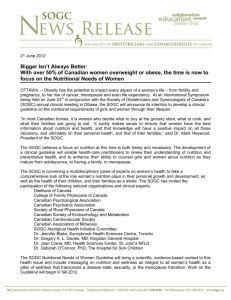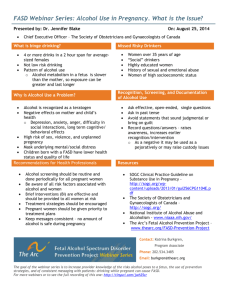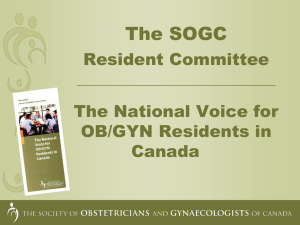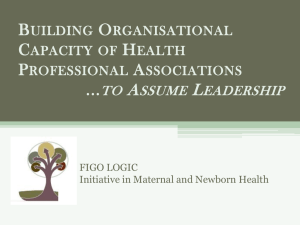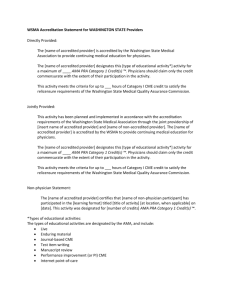Handbook for Planning Committees Developping
advertisement
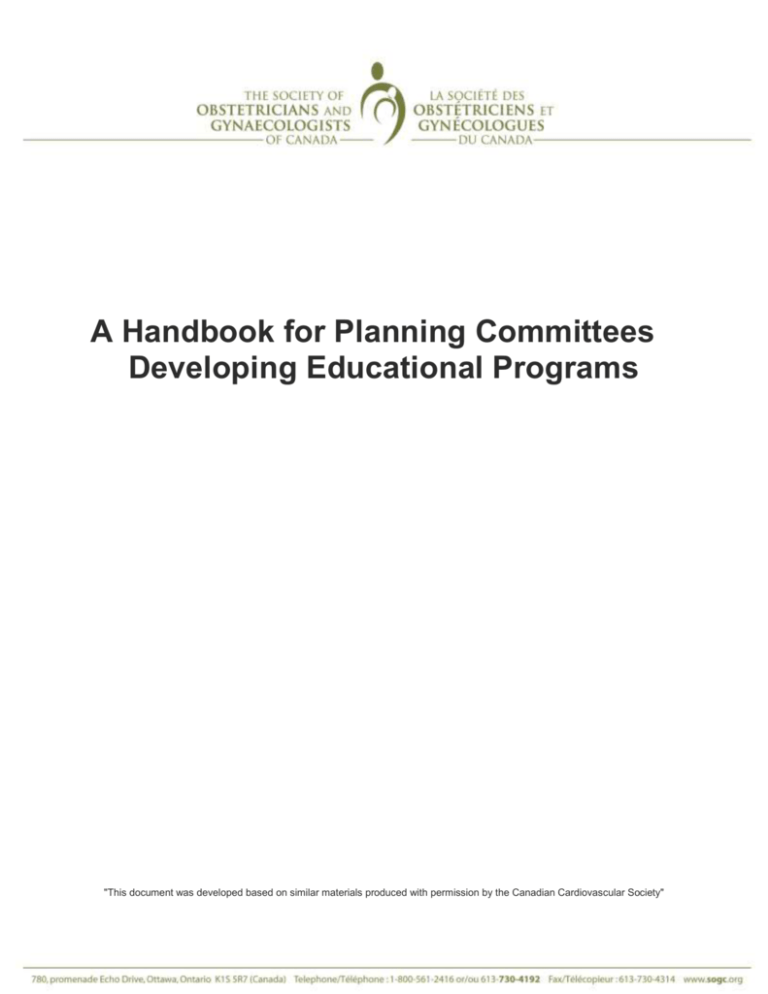
SOGC Handbook for Planning Committees Developing Educational Programs A Handbook for Planning Committees Developing Educational Programs "This document was developed based on similar materials produced with permission by the Canadian Cardiovascular Society" P a g e |1 SOGC Handbook for Planning Committees Developing Educational Programs Educational Program Development Cycle Step 1 Convene Planning Committee Step 8 Review the evaluation results, to discuss topics and priorities for future programs Step 2 Gather and review needs assessment information POST-EVENT Step 3 Create learning objectives based on identified educaitional needs EVENT OCCURS Step 4 Choose educational format and finalize proposed outline Step 5 Recruit faculty Step 7 Develop an evaluation strategy Step 6 Manage conflict of interest of faculty and Planning Committee P a g e |2 SOGC Handbook for Planning Committees Developing Educational Programs Step 1: Convene a planning committee Ensure that the Planning Committee is reflective of its target audience: The planning committee members must be representative of their intended target audience to ensure CPD goals and objectives are relevant and reflected in the scope of the events planned by the committee. • If applicable to family physicians, appropriate representation on the Planning Committee is required for MAINPRO® accreditation (similar Interprofessional representation would be beneficial if RNs or RMs are part of the target audience) Ensure that industry does not sit on the Planning Committee The Canadian Medical Association Policy, "Guidelines for Physicians in Interaction with Industry "(update 2007: Section 27)" indicates that, "Industry representatives should not be members of CME content planning committees. They may be involved in providing logistical support." The Royal College's interpretation of this section is as follows: "Membership of a scientific (content) planning committee for an accredited CPD activity must reflect the intended target audience. The integrity of the educational planning process therefor would prohibit the inclusion of industry representatives as members of scientific planning committees. Industry representatives could assist or contribute to overall steering or logistical planning groups." • Members of communication firm cannot sit on a planning committee either but can be involved with logistical planning. Step 2: Gather and review needs assessment information and unperceived needs data In order to develop activities that facilitate learning, it is essential that the planning committee implement a needs assessment strategy to enable the identification of the target audience's perceived and unperceived learning needs. By determining these needs, the planning committee will be able to establish general and event specific learning objectives to ensure that selected topics are relevant to the target audience. Perceived educational needs can be derived from the following sources: • Surveys • Questionnaires • Focus groups • Requests from the target audience • Results of evaluations from previous meetings P a g e |3 SOGC Handbook for Planning Committees Developing Educational Programs Unperceived educational needs can be derived from the following sources: • Self-assessment tests • Chart audits • Chart simulated recall interviews • Direct observation practice of performance • Emerging trends or special circumstances (disaster planning) • Topics less likely to be requested by physicians themselves • Quality assurance data from hospitals, regions, department heads, CMPA and patient care advocates • Standardized patients • Provincial databases • Incident reports • Guidelines and other published literature (RCT, cohort studies) It is best to use multiple sources of information and different methodologies to identify both the perceived and unperceived needs of the target audience. This research should lead to a clear description of the gap between present and optimal care. Step 3: Create learning objectives based on identified educational needs Learning objectives are derived from the needs assessment data. They enable participants in deciding whether a specific event or session meets their learning needs. Strong Learning objectives should: • Clearly outline the focus of the content, and the expected outcomes for all parties involved • Be linked to the identified needs • Be learner-centered and describe through action verbs, the specific knowledge, behavior, skill, attitude or learning outcomes that participants can anticipate from attending educational events • Be included in all conference material • Be provided to faculty prior to the program, so that they are aware of the educational needs that need to be addressed in their presentation • Avoid words such as "understand" ad they are not easily measured and open to many interpretations. Other verbs that should be avoided when creating learning objectives are: appreciate, have faith in; know; learn; believe Example of a strong Learning Objective: At the end of the session/event, participants will be able to: • Recognize the spectrum of severity among the various hereditary and acquired thrombophilias • Identify thrombophilic women who merit active thromboprophylaxis in pregnancy +Ior postpartum P a g e |4 SOGC Handbook for Planning Committees Developing Educational Programs • Be aware of the current evidence and recommendations regarding thrombophilic women who must have experienced adverse pregnancy outcomes You can find these verbs and other important information regarding learning objectives on the Royal College website at the following link: http://www.royalcollege.ca/portal/page/portal/rc/members/cpd/cpd_accreditation/group_le arning/cpd_accreditation_toolkit/learning_objectives Step 4: Choose the appropriate educational format for the program The development of the educational format should be designed to best present the content developed. For example, for controversial material, a debate may be an appropriate format, or for the content based on interprofessional issues, small group breakout groups may be appropriate. For skills development simulation or performance assessment activities may be appropriate. At least 25% of the total education time must be devoted to interactive learning strategies. Interactive learning needs to be a component of approved educational activities, whether they are face-to-face activities or asynchronous. As such, web-based or online sessions must meet the same standards for interaction as live events. Live event strategies include: • Discussion periods for questions • Panel discussions • Small breakout groups • Think, Pair, Share; opportunities to reflect and discuss content with a nearby colleague • Touch pad questions • Debate, etc. Web-based interactive strategies can include: • Discussion forums feedback board • Ask the expert • Twitter Step 5: Recruit faculty to present the content The planning committee must choose the appropriate faculty; this is a cornerstone for successful programs. The following recommendations should be kept in mind when choosing faculty: • They should have the expertise to present information based on the learning objectives provided P a g e |5 SOGC Handbook for Planning Committees Developing Educational Programs • They should be good communicators who are aware of the target audiences practice setting • They should have minimal conflict of interest with the program content. If a conflict of interest is present, this should be managed and disclosed at the beginning of their session • They should declare unapproved use of products or services. The only exception being where there is only one treatment or management strategy • They should consistently use either generic names, trade names or both generic and trade names during their presentation Step 6: Manage conflicts of interest of faculty and the planning committee All faculty and planning committee members are required to complete Conflict of Interest forms. A Conflict of Interest may occur in situations where personal and professional interest of individuals may have actual, potential or apparent influence over their judgment. All financial or 'in kind' relationships (not only those relevant to the subject being discussed) encompassing the previous two (2) years must be disclosed. All potential conflicts of interested related to educational activity must be revealed verbally, displayed in writing on a slide at the beginning of a presentation or included in the written conference materials. The Canadian Medical Association Policy, "Guidelines for Physicians in Interaction with Industry" (Update 2007: Section 24)" indicates that, "CME/CPD organizers and individual physician presenters are responsible for ensuring the scientific validity, objectivity and completeness of CME/CPD activities. Organizers and individual presenters must disclose to the participants at their CME/CPD events any financial affiliations with manufacturers of product mentioned at the event or with manufacturers of competing products." The intent is not to prohibit speakers from presenting, but rather to inform the audiences of any possible bias that the speakers may have. The following are some mechanisms that have been considered to resolve potential conflicts of interest: • Ask another faculty member without a conflict of interest based on that content to present that part of the program's conflict of interest • Ask the faculty member to withdraw from planning activities involving content in which they gave a conflict of interest if there may be a significant negative impact on the program • Limit the content of the faculty member's presentation so that recommendations for treatment are not included, or limit the recommendations to those based on clear evidences from medical literature P a g e |6 SOGC Handbook for Planning Committees Developing Educational Programs • The planning committee could ask for a peer review of the content to ensure that the principles of scientific integrity, objectivity and balance have been respected Step 7: Develop an evaluation strategy The planning committee must ensure that the individual sessions and the overall educational program are evaluated to determine their effectiveness in meeting the needs of the defined target audience. There should be a method to evaluate both individual sessions as well as the overall programming. The evaluation strategies should be focused on: • The degree to which the identified needs and learning objectives of individual events were achieved • The impact of the overall program on the learning outcomes identified by participants for their future performance • Whether there was any perception of commercial bias The following questions should be included within the evaluation form: • Rate the relevance of the program's content to the learner • Rate the educational effectiveness of the presenter • Rate the achievement of the stated learning objectives • Rate whether there were sufficient opportunities to for interaction • Provide feedback on their perception of any commercial or other inappropriate bias • Document what they have learned, become aware of and/or planning to change • List any topics for future programming • Provide any other written comments Step 8: Review the evaluation results and to discuss topics and priorities for future programs Reviewing the evaluation results is a valuable tool for the planning of future educational programs as they are a way to: • Identify the perceived needs of your target audience • Evaluate how effectively the learning objectives were met • Provide feedback to faculty regarding their session • Manage perceived bias for future programming • Identify topics and priorities for future programming Ethical Issues All Accredited educational events developed or co-developed with or by the SOGC must meet the CMA Guidelines governing the relationship between physicians and the pharmaceutical industry. It is important to keep in mind the following recommendations when developing or co-developing an educational program: P a g e |7 SOGC Handbook for Planning Committees Developing Educational Programs 1) Be aware of the potential for a conflict of interest that exists in acquiring sponsorship is imperative when planning an event or session. Any financial support from members of industry must be provided in the form of an educational grant and without any influence on the medical organization. 2) Ensure that there is no specific product branding on your program materials. Product branding on teaching aids is prohibited for all accredited areas by the SOGC. Teaching aids include the following: 3) PowerPoint presentations, presentation handouts, invitation and promotional items for accredited educational programs. Branding includes the use of markers, colors and shapes that are so recognizable that no text is necessary to identify the product. The organization must disclose any educational grant received at the beginning of the event verbally and on a slide or in writing in the final program. The Canadian Medical Association Policy, "Guidelines for Physicians in Interaction with Industry" (Update 2007: Section 50), "indicates that, "Practicing physicians may accept patient teaching aids appropriate to their area of practice provided these aids carry at most the logo of the donor company and do not refer to specific therapeutic agents, services or other products.” 4) Ensure that there is a declaration of all off-label use of drugs The Canadian Medical Association Policy, "Guidelines for Physicians in Interaction with Industry" (Update 2007: Section 30), "indicates that, "If specific products or services are mentioned, there should be a balanced presentation of the prevailing body of scientific information on the product or service and of reasonable, alternative treatment options. If unapproved uses of a product or service are discussed, presenters must inform the audience of this fact.” Unapproved use of products or services must be declared by faculty presenters. The only caveat to this guideline is where there is only one treatment or management strategy. 5) Ensure that faculty presentations are consistent in their use of either generic names, trade names or both generic and trade names during their presentation. The Canadian Medical Association Policy, "Guidelines for Physicians in Interaction with Industry" (Update 2007: Section 28), "indicates that, "Generic names should be used in addition to trade names in the course of CMElCPD activities." 6) Ensure that the event budget is appropriate P a g e |8 SOGC Handbook for Planning Committees Developing Educational Programs The Canadian Medical Association Policy, "Guidelines for Physicians in Interaction with Industry" (Update 2007: Section 32 & 33), "indicates that, "Travel and accommodation arrangements, social events and venues for industry sponsored CME/CPD activities should be in keeping with the arrangements that would normally be made without industry sponsorship. For example, the industry sponsor should not pay for travel or lodging costs or for other personal expenses of physicians attending a CME/CPD event. Subsidies for hospitality should not be accepted outside of modest meals or social events that are held as part of a conference of meeting. Hospitality and other arrangements should not be subsidized by sponsors for personal guests of attendees or faculty, including spouses or family members. All attendees at an event cannot be designated faculty. Faculty indicates a presenter who prepares and presents a substantive educations session in an area where they are recognized expert or authority. The physician organization accepts responsibility for the payment of honoraria, for faculty presenting at an accredited group learning activity. Physician organizations are accountable and responsible to ensure that all hospitality and other arrangements are modest and do not compete in any way with planned educational activities. Hospitality and other social arrangements must not be subsidized by sponsors for personal guests of attendees or faculty, including spouses or family members. Logistical aspects associated with faculty participation can be managed by industry and should be in keeping with arrangements that SOGC would normally confirm with industry support. 7) The event must not tag industry to a specific session within the overall conference. As of January 1st, 2010, the Royal College required that all accredited programs eliminate the practice of tagging. Tagging is the linking of sponsorship funding to a specific session within an accredited learning event. As of January 1, 2010, all sponsorship funds for accredited group learning events must be 7 received as an educational grant and included as a source of revenue within the overall budget supporting the event in its entirety. All organizations providing educational grants must be acknowledged as supporting the entire event. As an example, a summary page can be created recognizing the contribution of all sponsors. This acknowledgment should be recognized in conference materials separately from educational content. Non-educational activities may be 'tagged' but must not be included as part of an accredited group learning event. For example, a breakfast can be tagged, if it is strictly a meal function/social event and is not included as a program and cannot be in competition with an accredited session. P a g e |9 SOGC Handbook for Planning Committees Developing Educational Programs The role of the SOGC representative assigned to a planning committee What is an SOGC representative? When the SOGC co-develops an education activity with a non-physician organization for Section 1 MOC credits, the SOGC must designate representatives to sit on the planning committee from the inception to the conclusion of the program. The main responsibility of the SOGC representative is to ensure that the program is balanced, objective and free from commercial bias. The roles and responsibilities of the SOGC representative The SOGC representative is the eyes and ears of the SOGC on the co-developed program's planning committee. The SOGC representative's role is to oversee the development of the educational programming to ensure that Royal College educational and ethical standards are maintained throughout the planning process. As such, the SOGC representative has final approval of all aspects of the educational development of the program. The SOGC Representative would participate fully in the activities of the planning committee and is responsible for the following: • Participating in the planning committee from inception to completion of the activity • Ensuring that RCPSC guidelines are followed. • Ensuring the event is planned to address identified perceived and unperceived needs of the target audience • Ensuring that the learning objectives are based on identified educational needs • Ensuring that the event incorporates at least 25% of the total education time to interactive learning strategies • Ensuring the event includes and evaluation of learning for practice • Ensuring that the event approved under Section 1 meets the CMA Guidelines governing the relationship between physicians and the pharmaceutical industry • Ensuring the event's budget is appropriate. For example: no participant flights, accommodations, meals or other expenses paid for. • The SOGC representative is required to complete an audit form concerning the content development as part of the application. To help with the responsibility the SOGC has created a scientific content audit checklist for the use of the SOGC representative. This form is made available to planning committee members by SOGC once their participation is confirmed. http://sharepoint/services_products/Documents/Accreditation/prcHandbookPlanningCommittees.docx P a g e | 10

